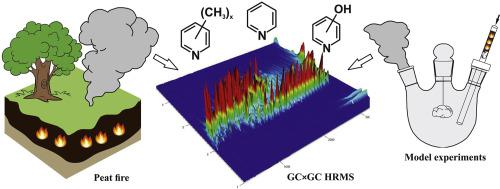Environmental Pollution ( IF 8.9 ) Pub Date : 2020-06-29 , DOI: 10.1016/j.envpol.2020.115109 Dmitry S Kosyakov 1 , Nikolay V Ul'yanovskii 1 , Tomas B Latkin 1 , Sergey A Pokryshkin 1 , Valeria R Berzhonskis 1 , Olga V Polyakova 2 , Albert T Lebedev 3

|
Studies of the chemical composition of atmospheric aerosols, rain water and snow in various regions of the globe quite often show the presence of pyridine and a number of its low mass derivatives. Nevertheless, the sources of those compounds in the environment have not yet been established and definitely require elucidation, supported by reliable experimental results. In the present work the chemical composition of peat combustion products as one of the important sources of atmospheric aerosol emission is studied by two-dimensional gas chromatography – high-resolution mass spectrometry with a focus on the detection of pyridine derivatives. Twenty-five compounds of this class were reliably identified and quantified in laboratory experiments on peat burning. Among them 3-hydroxypyridine predominates, while the rest analytes are mostly represented by alkyl derivatives: pyridine, 2-methylpyridine, 3-methylpyridine, 2,5-dimethylpyridine, 2,6-dimethylpyridine, 2-ethylpyridine, lutidines (in order of decreasing concentration). The distribution of these combustion products coincides with that obtained earlier in environmental studies carried out in Arctic, Central Russia and France. The experiments on peat thermal decomposition by pyrolysis GC-MS demonstrated that the maximum concentrations as well as the number of detected analytes were found under conditions of oxygen lack and a temperature of about 500 °C, i.e. characteristic conditions of peat wildfires. The observed levels of pyridines’ emission recalculated on the peat dry weight exceeded 200 mg kg−1. Considering hundreds of millions tons of peat burning in megafires over 20,000 tons of pyridines penetrate the Earth atmosphere annually. The obtained results allow concluding that peat burning may be the major and still underestimated source of pyridine and lower alkylpyridines in the Earth atmosphere.
中文翻译:

泥炭燃烧-地球大气中吡啶的重要来源。
对全球各个地区的大气气溶胶,雨水和雪的化学成分的研究经常显示出吡啶及其许多低质量衍生物的存在。然而,在可靠的实验结果的支持下,尚未确定环境中这些化合物的来源,因此绝对需要阐明。在目前的工作中,通过二维气相色谱-高分辨率质谱法研究了泥炭燃烧产物作为大气气溶胶排放的重要来源之一的化学成分,重点是吡啶衍生物的检测。在泥炭燃烧的实验室实验中,可靠地鉴定并定量了25种此类化合物。其中以3-羟基吡啶为主 其余的分析物主要由烷基衍生物表示:吡啶,2-甲基吡啶,3-甲基吡啶,2,5-二甲基吡啶,2,6-二甲基吡啶,2-乙基吡啶,二甲基吡啶(按浓度递减顺序排列)。这些燃烧产物的分布与早期在北极,俄罗斯中部和法国进行的环境研究中获得的分布相吻合。通过热解GC-MS对泥炭进行热分解的实验表明,在缺氧条件下和约500°C的温度(即泥炭野火的特征条件)下,可以找到最大浓度和检测到的分析物数量。根据泥炭干重重新计算的观察到的吡啶排放量超过200 mg kg 6-二甲基吡啶,2-乙基吡啶,二甲基吡啶(以浓度递减的顺序)。这些燃烧产物的分布与早期在北极,俄罗斯中部和法国进行的环境研究中获得的分布相吻合。通过热解GC-MS对泥炭进行热分解的实验表明,在缺氧条件下和约500°C的温度(即泥炭野火的特征条件)下,可以找到最大浓度和检测到的分析物数量。根据泥炭干重重新计算的观察到的吡啶排放量超过200 mg kg 6-二甲基吡啶,2-乙基吡啶,二甲基吡啶(以浓度递减的顺序)。这些燃烧产物的分布与早期在北极,俄罗斯中部和法国进行的环境研究中获得的分布相吻合。通过热解GC-MS对泥炭进行热分解的实验表明,在缺氧条件下和约500°C的温度(即泥炭野火的特征条件)下,可以找到最大浓度和检测到的分析物数量。根据泥炭干重重新计算的观察到的吡啶排放量超过200 mg kg 通过热解GC-MS对泥炭进行热分解的实验表明,在缺氧条件下和约500°C的温度(即泥炭野火的特征条件)下,可以找到最大浓度和检测到的分析物数量。根据泥炭干重重新计算的观察到的吡啶排放量超过200 mg kg 通过热解GC-MS对泥炭进行热分解的实验表明,在缺氧条件下和约500°C的温度(即泥炭野火的特征条件)下,可以找到最大浓度和检测到的分析物数量。根据泥炭干重重新计算的观察到的吡啶排放量超过200 mg kg-1。考虑到在大火中燃烧的亿吨泥炭,每年有超过20,000吨的吡啶渗透到地球大气中。获得的结果可以得出结论,泥炭燃烧可能是地球大气中吡啶和低级烷基吡啶的主要来源,但仍被低估了。

























 京公网安备 11010802027423号
京公网安备 11010802027423号